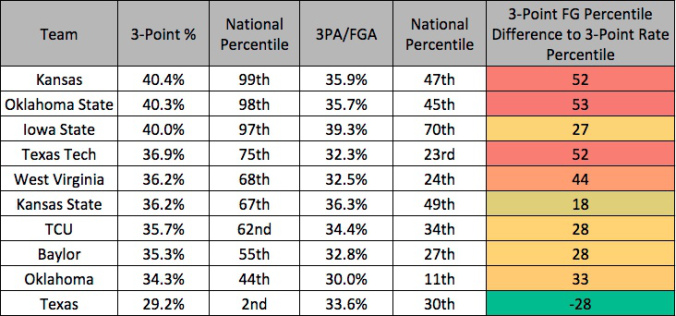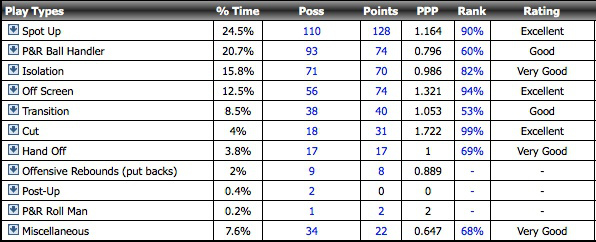Our projected 7th place finisher in the Big 12 this season: the Texas Tech Red Raiders
Key Details:
- Notable Departures: Anthony Livingston, Aaron Ross, Matthew Temple, Devon Thomas, Shadell Millinghaus
- Notable Returning Players: Keenan Evans, Zach Smith, Niem Stevenson, Justin Gray, Norense Odiase
- Notable Newcomers: Tommy Hamilton (Transfer from DePaul – C), Brandone Francis (Transfer from Florida – SG), Zhaire Smith (3 star SG), Davide Moretti (4 star PG), Jarrett Culver (3 star SG), Hyron Edwards (3 star JUCO G), Josh Webster (3 star JUCO PG), Malik Ondigo (3 star JUCO C)
- Link to Incoming Recruiting Class
- Projected Starting Five:
- Keenan Evans
- Niem Stevenson
- Justin Gray
- Zach Smith
- Norense Odiase
- Projected Bench Contributors:
- Tommy Hamilton
- Brandone Francis
- Zhaire Smith
- Davide Moretti
- Josh Webster
- Hyron Edwards
Outlook:
- Texas Tech heads into this season with simultaneously the most knowns and unknowns on a roster of any team in the Big 12. The Red Raiders are returning five seniors, who very likely will be their starting lineup. Other than those five guys, it’s an entirely new group behind them, consisting of 2 sit-out transfers, 3 JUCO transfers, and 3 incoming freshmen.
- This is not new for Chris Beard. He is one of the best JUCO recruiters in the country and is known for his ability to pick up signings in spring/early summer recruiting. The job that got him this job was when he coached a season at Little Rock (let’s not bring up UNLV). His Little Rock team that reached the tournament as a 12 seed had 10 newcomers that season, and Beard was able to get that roster to gel with all that uncertainty to make the NCAA Tournament. Beard faces far more certainty with his roster this season, but behind those five seniors, he’ll have to do some similar team-building and roster maneuvering to build a solid bench for a team that has postseason aspirations.
- Texas Tech probably should have made the NCAA Tournament last season. This is not an indictment on Chris Beard or their performance. They were just incredibly unlucky in an incredibly good league. Texas Tech lost many close games, including a double-OT loss to West Virginia and OT loss at home to Iowa State just three days later. They lost back-to-back one point games at TCU and home vs. Kansas. They also had close losses on the road to Iowa State, Baylor, and Texas. They were 333rd out of 351 teams nationally in the Kenpom metric “Luck” last season. Let’s just flip two of those four close games that I first mentioned. Now they finish Big 12 play 8-10, finish the regular season 20-11, and receive a NCAA Tournament bid. I’m sure that kept Chris Beard up at nights many times last season, but it just proves that they were better than their 6-12 conference record. We shouldn’t be surprised when they make the NCAA Tournament this season.
- Texas Tech’s biggest losses from last season were Anthony Livingston and Aaron Ross. Livingston was an effective offensive player and a good perimeter shooter for his size at 6’8″ (he shot 40% from 3), but he only played the 4th most minutes on the team at 58.1%, behind Smith, Evans, and Gray. Ross played the 7th most minutes on the team at 46.4%. He wasn’t disappointing last season, but I think Texas Tech fans probably expected a bit more from him last season after his surprising production as a junior. He was essentially the same player as a junior and a senior. So these departures matter, but they will be lessened by the return of Odiase and the development of Gray, Smith, Evans, and Stephenson.
- As far as the guys coming back, I am going to dive into Evans and Smith in greater detail in sections below, so let’s talk about Justin Gray, Niem Stevenson, and Norense Odiase.
- Odiase missed all but three games last season with a foot injury and received a medical redshirt. In 2016, he played in only 20 games after dealing with a foot injury that season as well. Odiase showed some potential as a freshman, which makes his injury history all the more upsetting. He’s got good size at 6’9″ and has apparently improved his body this offseason while rehabbing. He’s a good offensive rebounder (OReb % of 12.6% his freshman season) and gets fouled frequently (he can’t make said FTs but hopefully that’s something he worked on in his time off). I expect him and Tommy Hamilton to provide a nice 1-2 punch at the 5.
- Justin Gray is a curious case. The 6’6″ senior is an efficient player on offense, with an ORtg of 113.1 last season. He was terrific from 2-point range, shooting 58% on 2’s last season. What’s curious is his 3-point performance. Last season, he was 6-27 from 3 for a paltry 22%. As a sophomore, he was 22-52 for 42%. What happened? Gray was still productive as a mid-range shooter and took a fair amount of shots around the free-throw area and elbows. The hope for Texas Tech is that it was just a one-year blip and the result of a small sample size. If he can get back to being effective from 3, it gives Texas Tech more lineup versatility, as they could go “big” with him at the 3-spot and not have their floor spacing be harmed. Something to watch early in the season.
- Niem Stevenson was a surprise last season, simply because he was a JUCO transfer, and JUCO recruiting still isn’t scouted that intensely or well. Stevenson saw his minutes rise as the season progressed and started 7 of the final 10 games. He’s your typical 3-and-D guy. He’s 6’5″, he shot 38% from 3, he rebounded well with a DReb Rate of 18.7% (which was 9th in the conference), and he didn’t turn it over (his TO Rate of 12.1% was also 9th in the conference). 40% of his shots last season were spot-ups. I’m guessing that number will be very similar this season.
- Let’s dive into those unknown new guys. Tommy Hamilton and Brandone Francis are the two we know most about, simply because they have D-1 experience. Hamilton is 6’11” center who played three seasons at DePaul, averaging 8.6 PPG as a junior. Hamilton was an average offensive player from an efficiency standpoint at DePaul, which is surprising considering he can shoot it well from deep. He shot 45% from 3 as a junior on 58 attempts and 47% as a sophomore on 49 attempts. Why wasn’t he better on offense? He turned it over far too much and wasn’t good enough at making 2’s for his size. Let’s just look at his junior season. His TO Rate was 22%, which was 64th out of 70 qualifying players in the Big East. His 2-point FG% was average in the league, ranking 38th out of 70 qualifying players at 48.1%. Only two players taller than 6’7″ were worse than him. As a 6’11” center, he’s got to be better from close range.
- Francis got far less playing time at Florida as a redshirt freshman. He is now a junior due to using his redshirt at Florida. Francis didn’t get much playing time that season, only playing in 21.7% of minutes. His playing time decreased all season, and he only played in 2 of their last 7 games. Part of that was probably due to the fact that Francis was truly awful shooting the ball. He was 10-59 (17%) from 3 and 11-45 (24%) from 2-point range. His ORtg was 66.9, which is rough, to put it gently. The hope here is that the year off and the change in scenery gave Francis time to work on his offensive game and boosted his confidence. It’ll be tough to get minutes otherwise.
- Now it’s time for the major unknowns. JUCO scouting and recruiting rankings for JUCOs are truly terrible. So knowledge on JUCO players is always going to be a bit spotty. On 247Sports, Josh Webster and Hyron Edwards were ranked 18th and 27th, respectively. That range makes it unlikely, but not impossible, that they will have a major impact next season. Vladimir Brodziansky at TCU was ranked 20th in 2015. One of them could be a major surprise; the more likely scenario is that they are backups who are competing with the freshmen backcourt players for playing time.
- Those freshmen are Zhaire Smith, Davide Moretti, and Jarrett Culver. Culver is the most unlikely to contribute immediately this season, as he was ranked 312th on 247Sports. Moretti and Smith were ranked 95th and 194th, respectively. Moretti’s best skill is his perimeter shooting, and Smith is known for his athleticism and good size (he is 6’5″ compared to Moretti at 6’2″). Here is where Chris Beard will have to work his magic; one of these guys will likely need to contribute this season. It might just be for 8-10 minutes off of the bench, but they will be needed.
- Ultimately, I’d guess the Red Raiders starting lineup is Evans-Stevenson-Gray-Smith-Odiase with Hamilton, Francis, Webster, and Smith or Moretti rounding out the rotation. November and December will be the time when they determine who can be trusted out of those JUCO transfers and incoming freshmen.
Potential Pitfall: 3-Point Shooting… Will they actually shoot them?
- One of the easiest ways to be better offensively as a team is to shoot threes and be good at shooting those threes. Everyone gets that, it’s just simple math, right?
- For some reason, Texas Tech did not practice this strategy last season. The Red Raiders shot 36.9% from 3 as a team, which was good for 87th in the nation. There are 351 teams, so that puts them in the 75th percentile. Pretty good, right? Alright, let’s see how many threes they shot. Their 3PA/FGA rate (that essentially means what percentage of their shots are 3-pointers) was 32.3%, which was 271st in the country. That puts them in the 23rd percentile. Why?!? Why are they not shooting more threes?!? It is statistically irresponsible to shoot that percentage from 3 and then shoot so few threes. You are hurting your team by doing so.
- What makes it more maddening is that they had multiple guys who shot well from 3 with a large enough sample size. Evans shot 43% on 118 attempts, Livingston was at 40% on 138 attempts, Stevenson was at 38% on 72 attempts, Ross was at 38% on 80 attempts, and even Zach Smith was at 40% on 43 attempts. They had enough shooters that you can’t make the argument that their attempts were low due to only having one or two guys who can make threes.
- For comparison, Texas shot more threes than Texas Tech. Texas was 345th out of 351 teams in 3-point %, but yet they shot threes 33.6% of the time, a full percentage point more than Texas Tech. (Now we can get into Texas later in their preview, but maybe you guys shoot less threes, huh?)
- Take a look at this table. This is showing each Big 12 team, their FG% from 3, national percentile for 3P%, their 3PA/FGA, that percentile, and the difference between the percentiles.

- This table is sorted by 3-Point %. The percentile difference column is shaded, with more red signifying a shortage in the amount of threes you take considering your national rank in making them. As you can see, Texas Tech has a major shortage in the amount of threes they are taking; they should have taken more last season. Kansas and Oklahoma State had unbelievably good offenses last season (5th and 1st respectively), and you could make an argument they should have been shooting more threes as well.
- This gets into the old debate about the “live by the 3, die by the 3” adage. There is merit to that argument in a single game setting. If you’re struggling to make threes in an individual game, it can kill you if you don’t have an alternative plan on offense. BUT, over the course of the entire season, with a larger sample size, that adage loses any argumentative value in my mind. Over the course of 30+ games, if you are good at shooting threes, you should shoot more of them, not less. The percentages will bear out. You should not be in the 23rd percentile. I’m fascinated to see if Texas Tech overhauls their strategy and their offensive gameplan to account for their good shooters.
Player I’m Most Looking Forward to Watching: Keenan Evans
- Keenan Evans had an outstanding season last year, both from traditional statistical measures and analytical ones. He averaged 15.4 PPG / 3.0 APG / 2.8 RPG. He shot 43% from 3 and 48% from 2. His ORtg was 117.4, which was a big jump from his sophomore season rating of 103.6. Evans also did a good job getting to the line; he drew 4.9 fouls per 40 minutes, which was 8th best in the Big 12. He then would convert at the FT line, shooting 85% from the stripe. He was also incredibly consistent; he scored in double-digits in Texas Tech’s final 20 games. Evans just has a really good offensive profile.
- What can Evans improve on this season? He could find his teammates a little bit better. He wasn’t awful at this last season; he averaged those 3 assists per game and his Assist Rate was 21%. That was 14th in the Big 12, which isn’t bad at all. I think Tech would benefit if that was up around 25-27%. Last year, the top five in the Big 12 were Jawun Evans at 44.1%, Alex Robinson at 32.5%, Monte Morris at 32%, Andrew Jones at 26.5%, and Frank Mason at 26.1%. If Evans can get up around 25%, it’ll mean he’s creating more and better opportunities for his teammates than last year.
- Here is Evans’ shot profile from last season.

- There are a lot of good things here. He’s a terrific 3-point shooter, as shown by his numbers at the wing spots and at the top of the key. He was slightly below the league average of 52.6% at the rim, but as a guard, 51.8% certainly isn’t bad. One thing to watch out for this season, which is a similar observation I made in the Iowa State preview about Donovan Jackson, is that long 2-point range. Evans shot 13/36 on deep twos from the wing and free throw areas; that’s only 36%. He shot 47/113 from 3 in those court areas, which is 42%. Either pull up sooner and shoot a 3 or take another dribble and get into the mid-paint floater area or to the rim. If he doesn’t settle for those inefficient shots, his ORtg will get even higher this season.
- One last thing to keep an eye on–Evans wasn’t great in pick and roll last season. It was his least effective halfcourt play type last season (see charts below).


- In the 93 possessions he used in pick and roll, his PPP (points per possession) was only 0.79, which was in the 60th percentile. When he passed it as a pick and roll ball handler, PPP rose to an even 1.0, but still only in the 59th percentile. That’ll be something to watch for early in the season–will his pick-and-roll possessions result in more success for the team?
Player to Make the Biggest Jump: Zach Smith
- Zach Smith declared for the NBA Draft following last season, went through the process, and announced that he was returning to college on May 23rd. That was very good news for Big 12 fans who get to see another year of this athletic, long forward.
- Smith is 6’8″ and is all arms and legs. He’s got great length and is an explosive leaper, shot blocker, and rebounder. Look at where he ranked in the Big 12 for qualifying players in the following categories.
- OReb Rate: 9th, 10.7%
- DReb Rate: 8th, 18.8%
- Block Rate: 6th, 5.88%
- 3-Point %: 13th, 39.5%
- FT Rate: 16th, 38%
- Smith is a bit of a do-everything forward who always puts his imprint on the game, whether that’s through rebounding or defense or getting a huge offensive putback. This is probably why he was voted to the Preseason All Big 12 First Team; he is a coach’s dream.
- I haven’t yet touched on his best skill, which is his defensive ability. He is probably the best frontcourt defender in the league. He has great versaility; he is terrific at challenging shots at the rim, but he also has the foot speed and agility to switch onto guards and make it difficult for them. I hate most subjective player comps so I usually avoid making them, but I’ll make one here. Smith’s ability to switch onto guards and hold his own reminds me a bit of Joakim Noah in his best years with the Bulls. Smith is just plain good on that end of the court.
- Here is Smith’s shot chart.

- I’m intrigued to see if his shot profile looks differently this season. Mainly, will he shoot more threes? He only shot 43 last season, but I’m hoping that number will rise to around 60 or 70 this year as he has the ability to knock them down. Smith has an okay mid-range jumper. He shot 38/86 (44%) from what I deem the long-two and mid-paint areas (the first two rows/sections of zones inside the 3-point arc). He’s better at the wing and free throw area than he is from the baseline. He’s obviously great at the rim, which makes sense with his athleticism and length.
- I’m curious to see how Smith progresses this season. I’m sure he got advice on what he needs to do to make it at the next level during testing of the NBA Draft waters. I’d guess he shoots more threes this season, works on improving those percentages from midrange, and continues to be an absolute standout on defense. I’m excited to watch him. Now here are some dunks of his to enjoy (dunks are good, dunks are goooood).
Record/Postseason Projection: 8-10, NCAA Tournament Team
- I think Chris Beard gets his first NCAA Tournament bid at Texas Tech. The team does have some question marks and a handful of new players that Beard will have to integrate. But Beard has already proven in his career that he can do that. Those five seniors in the starting lineup should be very effective. Keenan Evans and Zach Smith are all-league caliber players. And I think Odiase and Hamilton give them some size and options down low that they didn’t have last season. I think they’ll finish league play anywhere from 8-10 to 10-8, but I feel confident that they’ll hear their name called on Selection Sunday.
Advertisements
Share this:
Like this:Like Loading...
Related











